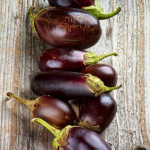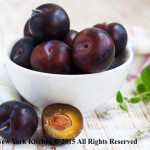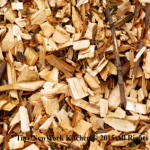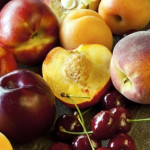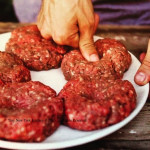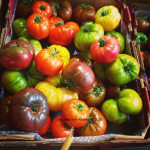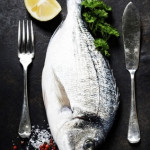Watermelon
Watermelon is the ultimate summer snack. As a kid growing up in Nebraska, my favorite way to eat watermelon was outside, with the juice running down my face and arms. Here is how I’m eating watermelon this summer.
Treat It Like A Steak
Cut watermelon into 2 inch slabs and drizzle with olive oil. Sprinkle with kosher salt and red pepper flakes. Eat with a steak knife.
Make A BLW
Forget the tomato and use a few thin slices of watermelon on your sandwich instead. Add some cheese for good measure.
Blitz It
Purée watermelon (seeds and all), strain, then add honey, and lime juice. Serve on ice with a mint sprig. Add rum or tequila if you want to be naughty.
“Work With What You Got!”
© Victoria Hart Glavin Tiny New York Kitchen © 2015 All Rights Reserved
Nebraska Corn
Growing up in Nebraska corn was a nightly summer menu item. The corn plant is Native American in origin and Nebraska is corn country. Driving through the state, one will see endless fields of sweet corn, feed corn, and pop corn. Small plot gardeners know that corn takes up a lot of space as it is greedy for soil nutrients, prone to weeds and disease, destroyed by small animals, wind and frost. So then why do we go through all the trouble of growing corn? Because no corn is as fresh and sweet as the corn you grow yourself.
The period of peak freshness for sweet corn is measured in minutes, not hours or days. The best corn is simply the freshest corn. Proper timing for harvest is crucial to the quality of sweet corn. Harvest sweet corn when the ears are full and blunt at the tip. The husks should be tightly folded and green. Using your thumbnail, poke and end kernel. It should squirt a milky white sap. Under ripe corn will contain a watery liquid. Overripe corn will have a tough skinned kernel with doughy interiors. Also look at the silk, which should be turning brown and dry on the end.
Storing sweet corn for long periods of time will destroy it. The sugar quickly turns to starch, losing flavor, quality, and most of all sweetness. If you must store sweet corn, use perforated plastic bags and get it into the refrigerator as soon as possible. Warm temperatures hasten the conversion process. Try to use the corn within 1 to 2 days and DO NOT husk until just prior to cooking.
“Work With What You Got!”
© Victoria Hart Glavin Tiny New York Kitchen © 2015 All Rights Reserved
Eggplant Know-How
Italian eggplant is the natural choice for classics like ratatouille and eggplant Parmesan, but varieties in different colors and shapes can be used interchangeably in many recipes. Prized for its dense, hearty texture and the ability to soak up flavor (it’s ideal for grilling), this vegetable can take the starring role in your next meal.
Selecting: If an eggplant is smooth and shiny and its skin bounces back when pressed, it’s a good one. Plus, it should feel heavy for it’s size.
Peak Season: July to October
Price: $1 to $5 per pound
Keeping It Fresh: Store in a cool, dry place at room temperature. Use it within two days or five days if refrigerated.
Pairs Well With: Tomatoes, zucchini, bell peppers, chickpeas, mint, and basil.
Creative Uses: Add Japanese eggplant to Thai coconut curry. Or Chop and stir-fry with baby bok choy and bell peppers.
Nutrition: Eggplant is rich in chlorogenic acid, an antioxidant compound that may aid in weight loss and regulation of lipid metabolism, as well as the anthocyanin phytonutrient, nasunin, which safeguards brain cell membranes.
“Work With What You Got!”
© Victoria Hart Glavin Tiny New York Kitchen © 2015 All Rights Reserved
For those of you who prefer an electric model ice cream machine, there are machines that can be had for under $50 that make a quart. The drum will need to be frozen before starting a batch. Larger machines range from $125 to $300. Cuisinart makes a model that produces two quarts in about 30 minutes, which is the ice cream maker that I used in this video.
Stores such as Williams-Sonoma sell ice cream starters that require a few simple added ingredients put into the machine to create ice cream. Personally, I don’t think that you need these starters.
There are endless combinations of ingredients that can be added to a batch of your homemade ice cream. Have fun experimenting with different flavors and add-ins. Enjoy summer with homemade ice cream that fits your personality.
“Work With What You Got!”
© Victoria Hart Glavin Tiny New York Kitchen © 2015 All Rights Reserved
5 Ways To Make The Most Of Plums
RAW
Pit and thinly slice for Spinach Salad with Plums and Goat Cheese
BAKED
Stone fruit crumbles, cobblers and crisps are hallmarks of late summer. Swap in plums for other stone fruits in your favorite recipes.
ROASTED/GRILLED
Roasting and grilling fruit brings out its inherent sweetness. Serve with crème fraiche, ice cream, or yogurt.
CANNED
Preserve plums by making jam, chutney, salsa, or a spicy sauce to enjoy the taste of summer year round.
DRIED
Dry slices in a low temperature oven for a sweet, chewy on the go snack, which are perfect for packed lunches.
“Work With What You Got!”
© Victoria Hart Glavin Tiny New York Kitchen © 2015 All Rights Reserved
Soaking Wood Chips In Beer For Grilling
Here is a secret. You can turn your gas or charcoal grill into a smoker by just using beer. Soak wood chips in beer before you fire up the grill. The beer will be imparted into your smoked food.
Soak wood chips in beer for at least 30 minutes. The wet wood chips will produce more smoke and flavor. Drain wood chips and sprinkle a handful of soaked chips over the hot coals when they are ready and covered with a white ash. Put the lid on the grill and wait for the smoke to start to pour out of the grill. Then place the food on the cooking grate.
For charcoal grills, position it so that the vent is on the side of the grill opposite the charcoal. This will draw the heat and smoke over the food and out of the vent.
For gas grills, when using wood chips with a gas grill, follow the smoker box instructions for best results.
A couple of handfuls of wood chips will provide 10 to 20 minutes of smoke, depending on how hot the fire is.
Keep the grill lid closed as much as possible to allow the smoke to fully permeate the food.
Always use heat-resistant barbecue mitts or gloves when operating your grill.
“Work With What You Got!”
© Victoria Hart Glavin Tiny New York Kitchen © 2015 All Rights Reserved
5 Ways to Make the Most of Seasonal Stone Fruit
Ripen: Ripen peaches, nectarines and apricots at room temperature. Once ripe, they can be refrigerated for just a few days to help keep them at their best.
Speed Up: Speed up the ripening process by placing fruit in a brown paper bag on the counter, checking a few times each day.
Can: Preserve stone fruits by canning them (make jam, syrup or salsa) to enjoy the taste of summer year-round.
Dry: Bake or grill halves or slices at 200 degrees for about 3 hours, turning every 30 minutes or so, until dehydrated yet still soft. Store in the refrigerator.
Freeze: Lightly poach halved and pitted fruit in water (sugar optional), portion and freeze for later use in smoothies, baking, desserts or fruit sauce for pancakes.
“Work With What You Got!”
© Victoria Hart Glavin Tiny New York Kitchen © 2015 All Rights Reserved
Burgers 101
Whether you’re cooking on a gas or charcoal grill or in a fry pan on the stovetop, here are tips on making the perfect burger that is meaty and satisfying, yet never dense and bricklike. To make the best burgers, use a light touch with the meat.
DON’T FEAR THE FAT For the juiciest beef burgers, use ground chuck (80% lean/20% fat) or sirloin (85% lean/15% fat). Leaner cuts and grass-fed beef will yield a drier burger. When buying chicken or turkey, opt for dark meat. It’s still lower in fat than beef and will result in a much tastier burger than white meat.
FRESH IS BEST Keep in mind that you don’t need to buy ground meat. You can choose any boneless cut and then ask your butcher to grind it for you or grind it yourself. Use a coarser grind to avoid a mushy texture. For a special treat add some freshly ground short ribs, dry-aged steak, brisket or a combination.
MAKE AN IMPRESSION The edges of a burger cook faster than the center, which can cause the burger to puff up into a sphere. To avoid this, when shaping the patty, press your thumb into the center to make a dimple about the size of a quarter.
HOLD THE SALT Wait to add salt until after the patties are formed and just before cooking, and then season generously. Salt inside a patty will start to dissolve the protein strands, which will adversely affect the texture of the burger.
GRILL OR GRIDDLE Burger lovers are divided about the best cooking method. Grilling adds terrific smoky flavor, but some insist that a griddle or fry pan allows the flavorful fat to stay with the burger during cooking. Whichever method you choose, DO NOT press down on the meat with the spatula because it will release the juices and fat. Resist that urge!
DON’T FLIP OUT Flip the burgers only once, and only after they have formed a nice brown seal. Don’t flip too soon, and don’t move the burgers around. When the burgers are ready to be flipped, they should dislodge from the cooking surface easily. If they stick, let them cook for a few moments more.
COOKED TO PERFECTION The surest way to measure a burger’s doneness is to check the internal temperature with an instant-read thermometer. The thickest part of a beef burger should register 130 degrees for medium-rare, 140 degrees for medium, and 150 degrees for well done. Let your burgers rest for a couple of minutes before serving to allow the internal juices to redistribute evenly through the meat.
“Work With What You Got!”
© Victoria Hart Glavin Tiny New York Kitchen © 2015 All Rights Reserved
Certain Produce Shouldn’t Be Stored In The Refrigerator
With some fruits and vegetables cold temperatures can lead to unsavory textures and flavors. Let tomatoes sit on the counter at room temperature, and store onions, garlic, and potatoes separately in a cool, dark place in perforated baskets or bins to allow for good airflow. Make sure to keep all fresh produce away from direct sunlight.
Onions & Garlic can lose crispness and become moldy when exposed to the refrigerator’s moisture. They can also impart their flavors on foods stored nearby.
Tomatoes flavor often diminishes when they’re chilled, and the texture can turn mealy as the cold temperature breaks down the membranes inside the fruit.
Potatoes starch content converts to sugar when cold, which leads to an unpleasantly sweet taste and discoloration when they’re cooked.
“Work With What You Got!”
© Victoria Hart Glavin Tiny New York Kitchen All Rights Reserve
Cooking Fish
Here is the simple secret to cooking fish successfully: Just don’t overcook it. Cook it until the flesh is just opaque throughout, as it will continue to cook after it has been removed from the heat.
Before cooking fillets, especially thick ones, run your fingers over the flesh to feel for any stray bones. Remove them with tweezers set aside for that purpose.
To check fish fillets or steaks for doneness, use the tip of a small knife to separate the flesh in the thickest part. It should be uniformly opaque. To check whole fish, make an incision at the backbone to see if the flesh is opaque or insert and instant-read thermometer in the thickest part near the backbone. The thermometer should read 135 to 140 degrees.
Before cooking clams, mussels, or oysters, scrub the shells well under cold running water to remove any surface sand and grit.
“Work With What You Got!”
© Victoria Hart Glavin Tiny New York Kitchen All Rights Reserve



